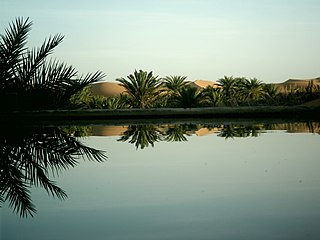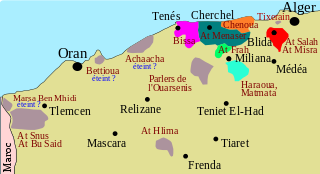
The Berber languages, also known as the Amazigh languages or Tamazight, are a branch of the Afroasiatic language family. They comprise a group of closely related languages spoken by Berber communities, who are indigenous to North Africa. The languages were traditionally written with the ancient Libyco-Berber script, which now exists in the form of Tifinagh. Today, they may also be written in the Berber Latin alphabet or the Arabic script, with Latin being the most pervasive.

Korandje is a Northern Songhay language which is by far the most northerly of the Songhay languages. It is spoken around the Algerian oasis of Tabelbala by about 3,000 people; its name literally means "village's language". While retaining a basically Songhay structure, it is extremely heavily influenced by Berber and Arabic; about 20% of the 100-word Swadesh list of basic vocabulary consists of loans from Arabic or Berber, and the proportion of the lexicon as a whole is considerably higher.

Shawiya, or Shawiya Berber, also spelt Chaouïa, is a Zenati Berber language spoken in Algeria by the Shawiya people. The language's primary speech area is the Awras Mountains in Eastern Algeria and the surrounding areas, including parts of Western Tunisia, including Batna, Khenchela, Sétif, Oum El Bouaghi, Souk Ahras, Tébessa and the northern part of Biskra. It is closely related to the Shenwa language of Central Algeria.
The Zenati languages are a branch of the Northern Berber language family of North Africa. They were named after the medieval Zenata Berber tribal confederation. They were first proposed in the works of French linguist Edmond Destaing (1915) (1920–23). Zenata dialects are distributed across the central Berber world (Maghreb), from northeastern Morocco to just west of Algiers, and the northern Sahara, from southwestern Algeria around Bechar to Zuwara in Libya. The most widely spoken Zenati languages are Tmazight of the Rif in northern Morocco and Tashawit Berber in northeastern Algeria, each of which have over 3 million speakers.

Tmazight or Tarifit Berber, also known as Riffian is a Zenati Berber language spoken in the Rif region in northern Morocco. It is spoken natively by some 1,271,000 Rifians primarily in the Rif provinces of Al Hoceima, Nador and Driouch. Tarifit is strongly influenced by the Arabic language, and borrowed foreign loanwords represent 51.7% of the total Tarifit vocabulary.

The Chaoui people or Shawia are an Amazigh (Berber) ethnic group to the Aurès region in northeastern Algeria which spans Batna and Khenchla, Oum El Bouaghi provinces located in and surrounded by the Aurès Mountains.

Igli is a town and commune in Béchar Province, western Algeria, located 152 km south of Bechar. It is coextensive with Igli District. Its population was 6,682 as of the 2008 census, up from 5,474 in 1998, and an annual population growth rate of 2.1%. The commune covers an area of 6,220 square kilometres (2,400 sq mi).

Central Atlas Tamazight or Atlasic is a Berber language of the Afroasiatic language family spoken by 2.3 million in the Atlas Mountains of Central Morocco as well as by smaller emigrant communities in France and elsewhere.
Ghadamès is a Berber language that is spoken in, and named after, the oasis town of Ghadames in Nalut District, western Libya.

Tiout is a municipality in Naâma Province, Algeria. It is part of the district of Aïn Séfra and has a population of 3,161, which gives it 11 seats in the PMA. Its postal code is 45210 and its municipal code is 4504.
Tetserret is a Western Berber language spoken by the Ait-Awari and Kel Eghlal Tuareg tribes of the Akoubounou (Akabinu) commune in Niger. This main speech area is located between Abalak, Akoubounou and Shadwanka. The variant spoken by the Kel Eghlal is called taməsəɣlalt. The Tamasheq equivalent shin-sart / shin-sar / tin-sar is used in some older literature. Popular understanding among some Ait-Awari derives the name tet-serret, and its Tamasheq equivalent shin-sart, from expressions meaning 'the (language) of Sirte'.

Tamazight of Djerba, Chelha of Djerba, or Djerbi is a Berber language of the Eastern Maghreb, spoken on the island of Djerba, in Tunisia. It is a component of what is regularly denominated Tunisian “Chelha”, in the south of the country.
Beni Snous is a Berber variety close to Zenati languages spoken near Tlemcen in Algeria.

Gurara (Gourara) is a Zenati Berber language spoken in the Gourara (Tigurarin) region, an archipelago of oases surrounding the town of Timimoun in southwestern Algeria. Ethnologue gives it the generic name Taznatit ("Zenati"), along with Tuwat spoken to its south; however, Blench (2006) classifies Gurara as a dialect of Mzab–Wargla and Tuwat as a dialect of the Riff languages.

Ouargli, or Teggargrent, is a Zenati Berber language. It is spoken in the oases of Ouargla (Wargrən) and N'Goussa (Ingusa) in Algeria.

Matmata Berber is a Zenati Berber dialect spoken around the town of Matmâta in southern Tunisia, and in the villages of Taoujjout, Tamezret and Zrawa. According to Ben Mamou's lexicon, its speakers call it Tmaziɣṯ or Eddwi nna, meaning "our speech", while it is called Shelha or Jbali (جبالي) in local Tunisian Arabic dialects. The total population speaking this variety was estimated at 3,726 in 1975.
André Basset was a French linguist. René Basset was his father and Henri Basset his older brother.

The Ksour Range or Kçour Range is a mountain range in Algeria. Stretching across the provinces of Béchar and El Bayadh, it is the westernmost range of the Saharan Atlas, with the Amour Range further east.

The Western Algerian Zenatic dialects are a diffuse set of Zenati Berber dialects spoken in north-western Algeria, west of the capital Algiers.
Maarten Kossmann is a Dutch linguist who specializes in Berber languages. He is currently professor of Berber studies at Leiden University.













